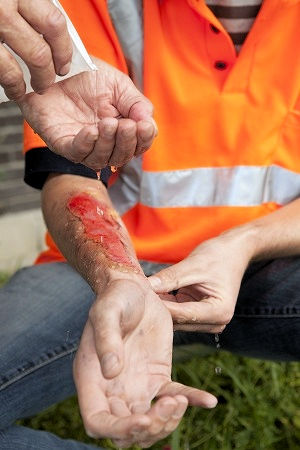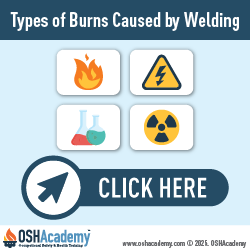Injuries
Welding, cutting, brazing, and soldering can cause wounds and other physical injuries including cuts, abrasions, burns, and electrical shock.

Wounds
Wounds are classified according to the following:
- General Condition: Clean, contaminated, infected, or healing wounds.
- Size and Depth: Superficial (minor cuts or scrapes), deep (penetrating deeper tissue layers), or extensive (covering larger areas).
- Location: The specific body part affected—such as limbs, torso, head, or face.
- Type of Tissue Damage: How the skin or underlying tissue is injured, such as lacerations (cuts), punctures, abrasions, contusions (bruises), or burns.
- Cause or Mechanism: What caused the injury, such as electrical shocks, thermal exposure, mechanical impact, chemical exposure, or radiation (UV radiation from welding arcs).
Electric Shock
Welders could accidentally suffer an electrical shock, which could cause a loss of balance. This could result in a minor or serious injury. Because workplace injuries can occur, welders should know the basics of first aid.
Burns
Burns are among the most common and potentially severe injuries. The causes of burns are generally classified as thermal, electrical, chemical, or radiation. Whatever the cause, shock always results if the burns are extensive. The four types of common burns experienced by welders include:
- Thermal burns are caused by exposure to intense heat, such as that generated by fire, bomb flash, sunlight, hot liquids, hot solids, and hot gases. Their care depends upon the severity of the burn and the percentage of the body area involved.
- Electrical burns are caused by electric current passing through tissues or superficial wounds caused by an electrical flash. They may be far more serious than they first appear. The entrance wound may be small; but as electricity penetrates the skin, it burns a large area below the surface. Usually there are two external burn areas: one where the current enters the body and another where it leaves.
- Chemical burns are generally not caused by heat, but by the direct chemical destruction of body tissues. When acids, alkalis, or other chemicals come in contact with the skin or other body membranes, they can cause injuries generally referred to as chemical burns. The extremities, mouth, and eyes are the areas that are most often affected. Alkali burns are usually more serious than acid burns because they penetrate longer. When chemical burns occur, carry out emergency measures immediately. Do not wait for the arrival of medical personnel.
- Radiation burns are caused by prolonged exposure to ultraviolet radiation. First- and second-degree burns may develop. Treatment is essentially the same as that for thermal burns.
Ergonomic Injuries
Welding, cutting, brazing, and soldering often require repetitive motion, awkward positions, and heavy tools. These actions can lead to several ergonomic injuries if proper safety measures are not followed.
- Muscle Strains are caused by lifting heavy tools or staying in awkward positions for long periods.
- Back Injuries result from bending or twisting the body repeatedly during work.
- Shoulder and Neck Pain occurs when working overhead or in cramped spaces.
- Tendonitis is inflammation in tendons due to repeated arm or wrist movements.
- Carpal Tunnel Syndrome is caused by pressure on wrist nerves from gripping tools tightly.
- Bursitis is swelling in joints like the elbows from leaning on hard surfaces.
Knowledge Check Choose the best answer for the question.
2-8. What is the most common type of physical injury to welders?
You forgot to answer the question!

